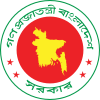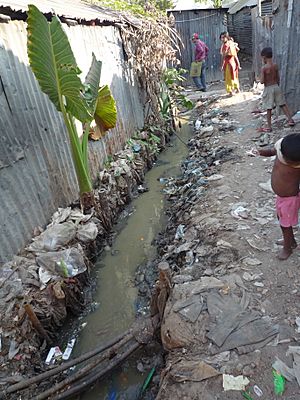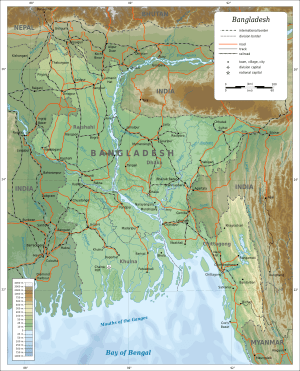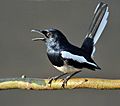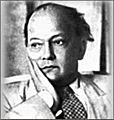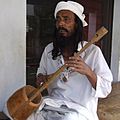Bangladesh facts for kids
Quick facts for kids
People's Republic of Bangladesh
|
|
|---|---|
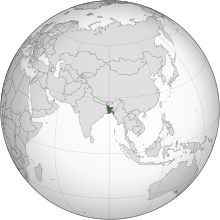 |
|
| Capital and largest city
|
Dhaka 23°45′50″N 90°23′20″E / 23.76389°N 90.38889°E |
| Official language and national language |
Bengali |
| Recognised foreign language | English |
| Ethnic groups
(2022 census)
|
99% Bengali |
| Religion
(2022 census)
|
|
| Demonym(s) | Bangladeshi |
| Government | Unitary parliamentary republic under an interim government |
| Mohammed Shahabuddin | |
|
• Chief Adviser
|
Muhammad Yunus |
| Syed Refaat Ahmed | |
| Legislature | Jatiya Sangsad |
| Independence from Pakistan | |
|
• Proclamation of independence
|
26 March 1971 |
|
• Victory
|
16 December 1971 |
|
• Current constitution
|
16 December 1972 |
| Area | |
|
• Total
|
148,460 km2 (57,320 sq mi) (92nd) |
|
• Water (%)
|
6.4 |
|
• Land area
|
130,170 km2 |
|
• Water area
|
18,290 km2 |
| Population | |
|
• 2024 estimate
|
173,562,364 (8th) |
|
• 2022 census
|
169,828,911 (8th) |
|
• Density
|
1,165/km2 (3,017.3/sq mi) (13th) |
| GDP (PPP) | 2024 estimate |
|
• Total
|
|
|
• Per capita
|
|
| GDP (nominal) | 2024 estimate |
|
• Total
|
|
|
• Per capita
|
|
| Gini (2022) | ▲ 49.9 high |
| HDI (2022) | medium · 129th |
| Currency | Taka (৳) (BDT) |
| Time zone | UTC+6 (BST) |
| Driving side | left |
| Calling code | +880 |
| ISO 3166 code | BD |
| Internet TLD | .bd .বাংলা |
Bangladesh (officially called People's Republic of Bangladesh) is a country in South Asia. It is next to the North-east Indian provincial regions of India, which converges with Southeast Asia to the east. Its full name is The People's Republic of Bangla-Desh. The capital and the largest city is Dhaka (also spelled 'Dacca'). Bangladesh is surrounded on all three sides by the Republic of India (Bharat), and Myanmar (Burma) on the south-eastern corner, it is near the People's Republic of China, Bhutan, Sikkim and Nepal. Its independence was fully realised after it declared it self as independent most of 1971 from Pakistan after a bloody war in which over a million people died. Later by Indian military intervention, by that time the provisional government went into exile in Calcutta, Bengal (India) which they considered their homeland to be under Pakistani military occupation. After the Instrument of Surrender, the Bengali peoples became a sovereign nation and when its founder was released from political imprisonment had returned in 1972. Present-day Bangladesh has an area of 56,977 mi² or (147,570 km²).
The local currency is called Taka. The official language is Bengali.
There are two main rivers in Bangladesh, the Ganges and Brahmaputra Rivers are holy to Hindus. There are often floods because of these two rivers.
Contents
History
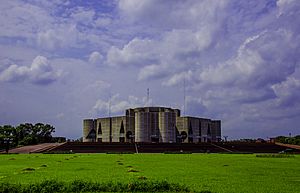
Earliest civilizations
The delta and surrounding hills has been inhabited for hundreds of generations (thousands of years). The area supported agriculture very early on. About 500 BC there was a shift to growing rice. This led to the development of urban areas. Because there were no stone quarries in the area houses were built of wood and mud (including adobe). Because of the monsoon climate very little evidence of the earliest inhabitants remains. From about 300 BC to the 1700s AD the Bengal delta saw the development of writing, the Bengali language, religions and the rise and fall of states. By the 1500s, the area was prosperous and even peasants had plenty to eat.
Political states
For much of its history the area was simply called "Bengal" and was considered a part of India. The last few centuries several foreign powers involved themselves with the area resulting in several wars. The 20th century brought more wars, genocide, and political states. Bengal was under British rule from 1757–1947. It was a part of British India. In 1947 East Bengal and West Pakistan separated from India and formed a new country called Pakistan. But the east and west provinces were on either side of India and separated by 930 miles (1,500 km). In 1949 the Bangladesh Awami League formed to favor separation between east and west Pakistan. In 1955 East Bengal was renamed East Pakistan. Dacca was then the legislative capital of Pakistani Bengal provincial region. The peoples of East Pakistan were mostly ethnic Bengalis who had a different language and culture to the people of western Pakistan. These differences eventually led to the Bangladesh Liberation War. On 16 December 1971, Bangladesh gained independence, with the help of allied forces against West Pakistani forces.
The East Bengal Legislative Assembly was the law-making body of the province of East Bengal. It was later renamed the East Pakistan Legislative Assembly and would be succeeded by the Jatiyo Sangshad in 1971.
After the birth of Bangladesh, Bangla replaced Urdu and English as the sole national and official language, and was the language taught in schools and used in business and government. The Bangla Academy was important in this change. In the 1980s, British-style education was maintained through private English-language institutions attended by upper class children. English continued to be taught in higher education and was offered as a subject for university degrees.
At first, Arabic also lost ground in independent Bangladesh. This trend ended in the late 1970s, however, after Bangladesh strengthened its ties with Saudi Arabia and other oil-rich, Arabic-speaking countries. An unsuccessful attempt was made in 1983 to introduce Arabic as a required language in primary and secondary levels. Arabic is widely studied in Madrassas and Islamic institutions around the country for better understanding of the Quran, Hadith and any other Islamic texts.
Difficulties
Despite many years of independence, Bangladesh is still a poor country and has problems with corruption and political troubles as the other country have. Presently more than half of the people can read and write.
Bangladesh has heavy cyclones and natural disasters, due to this many lives are often lost. The country is one of the most densely populated in the world. Cyclones are very common in the Bay of Bengal during the middle of the year, particularly in the south of country in areas like Sundarban, Chittagong, Cox's Bazaar,or in neighboring Myanmar and Republic of India. Despite the many storms, Bangladesh does not have a very effective storm prevention system, and cyclones usually inflict heavy damage.
Health and sanitation
The most difficult problem to tackle in this country is perhaps the environmental sanitation problem. There is a lack of safe drinking water in many areas of the country and in some areas no proper toilets or sewage systems.
- No toilets resulting in filth and water born disease like diarrhea, dysentery, enteric fever, hepatitis, hook worm infestations.
- Poor rural housing with no arrangement for proper ventilation, lighting etc.
- Poor sanitation of public eating and market places.
- Inadequate drainage, disposal of refuse and animal waste.
- Absence and/ or adequate health education to the rural areas.
- Absence and/or inadequate communications and transport facilities for workers of the public health.
Geography
Bangladesh is a small, lush country in South Asia, located on the Bay of Bengal. It is surrounded almost entirely by neighbouring India—and shares a small border with Myanmar to its southeast, though it lies very close to Nepal, Bhutan, and China. The country is divided into three regions. Most of the country is dominated by the fertile Ganges Delta, the largest river delta in the world. The northwest and central parts of the country are formed by the Madhupur and the Barind plateaus. The northeast and southeast are home to evergreen hill ranges.
The Ganges delta is formed by the confluence of the Ganges (local name Padma or Pôdda), Brahmaputra (Jamuna or Jomuna), and Meghna rivers and their respective tributaries. The Ganges unites with the Jamuna (main channel of the Brahmaputra) and later join the Meghna, finally flowing into the Bay of Bengal. Bangladesh is called the "Land of Rivers"; as it is home to over 57 trans-boundary rivers, the most of any nation-state. Water issues are hence politically complicated inasmuch as the country is a lower riparian state to India.
Bangladesh is predominantly rich fertile flat land. Most of it is less than 12 m (39 ft) above sea level, and it is estimated that about 10% of its land would be flooded if the sea level were to rise by 1 m (3.3 ft). 17% of the country is covered by forests and 12% is covered by hill systems. The country's haor wetlands are of significance to global environmental science. The highest point in Bangladesh is the Saka Haphong, located near the border with Myanmar, with an elevation of 1,064 m (3,491 ft). Previously, either Keokradong or Tazing Dong were considered the highest.
Biodiversity
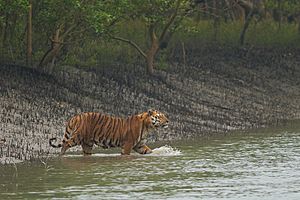
Bangladesh is located in the Indomalayan realm, and lies within four terrestrial ecoregions: Lower Gangetic Plains moist deciduous forests, Mizoram-Manipur-Kachin rain forests, Sundarbans freshwater swamp forests, and Sundarbans mangroves.
Its ecology includes a long sea coastline, numerous rivers and tributaries, lakes, wetlands, evergreen forests, semi evergreen forests, hill forests, moist deciduous forests, freshwater swamp forests and flat land with tall grass. The Bangladesh Plain is famous for its fertile alluvial soil which supports extensive cultivation.
The country is dominated by lush vegetation, with villages often buried in groves of mango, jackfruit, bamboo, betel nut, coconut and date palm. The country has up to 6000 species of plant life, including 5000 flowering plants. Water bodies and wetland systems provide a habitat for many aquatic plants. Water lilies and lotuses grow vividly during the monsoon season. The country has 50 wildlife sanctuaries.
Bangladesh is home to much of the Sundarbans, the world's largest mangrove forest, covering an area of 6,000 km2 in the southwest littoral region. It is divided into three protected sanctuaries–the South, East and West zones. The forest is a UNESCO World Heritage Site. The northeastern Sylhet region is home to haor wetlands, which is a unique ecosystem. It also includes tropical and subtropical coniferous forests, a freshwater swamp forest and mixed deciduous forests. The southeastern Chittagong region covers evergreen and semi evergreen hilly jungles. Central Bangladesh includes the plainland Sal forest running along the districts of Gazipur, Tangail and Mymensingh. St. Martin's Island is the only coral reef in the country.
Bangladesh has an abundance of wildlife in its forests, marshes, woodlands and hills. The vast majority of animals dwell within a habitat of 150,000 km2. The Bengal tiger, clouded leopard, saltwater crocodile, black panther and fishing cat are among the chief predators in the Sundarbans. Northern and eastern Bangladesh is home to the Asian elephant, hoolock gibbon, Asian black bear and oriental pied hornbill.
The Chital deer are widely seen in southwestern woodlands. Other animals include the black giant squirrel, capped langur, Bengal fox, sambar deer, jungle cat, king cobra, wild boar, mongooses, pangolins, pythons and water monitors. Bangladesh has one of the largest population of Irrawaddy dolphins and Ganges dolphins. A 2009 census found 6,000 Irrawaddy dolphins inhabiting the littoral rivers of Bangladesh. The country has numerous species of amphibians (53), reptiles (139), marine reptiles (19) and marine mammals (5). It also has 628 species of birds.
Divisions
Bangladesh is divided into seven administrative divisions,: Barisal (বরিশাল), Chittagong (চট্টগ্রাম), Dhaka (ঢাকা), Khulna (খুলনা), Rajshahi (রাজশাহী), Sylhet (সিলেট), and Rangpur (রংপুর).
Divisions are divided into districts. There are 64 districts in Bangladesh.
Dhaka is the capital and largest city of Bangladesh. Other major cities include Chittagong, Khulna, Rajshahi, Sylhet, Barisal, Bogra, Comilla, Mymensingh and Rangpur. For more locations see List of settlements in Bangladesh.
| City | City population (2008 estimate) | Metro population (2008 estimate) |
|---|---|---|
| Dhaka | 7,000,940 | 12,797,394 |
| Chittagong | 2,579,107 | 3,858,093 |
| Khulna | 855,650 | 1,588,425 |
| Rajshahi | 472,775 | 775,496 |
| Sylhet | 463,198 | – |
| Barisal | 210,374 | – |
| Rangpur | 241,310 (2001) | 251,699 (2001) |
Religion
The main religion in Bangladesh is Islam (85%). Many people also follow Hinduism (14%). Most Muslims are Sunni. Islam was made the state religion in the 1980s. Christians make up less than 1% of the population.
Culture
The earliest literary text in Bengali is the 8th century Charyapada. Medieval Bengali literature was often either religious or from other languages. The 19th century had poets such as Rabindranath Tagore, Michael Madhusudan Dutt and Kazi Nazrul Islam.
The musical tradition of Bangladesh is lyrics-based with little instruments. Folk music is often accompanied by the ektara, an instrument with only one string. Bangladeshi dance forms are from folk traditions.
Bangladesh makes about 80 films a year. Mainstream Hindi films are also quite popular. Around 200 daily newspapers are published in Bangladesh, along with more than 500 magazines.
Rice and fish are traditional favourite foods. Biryani is a favourite dish of Bangladeshis.
The sari is by far the most widely worn dress by Bangladeshi women.The salwar kameez (shaloar kamiz) is also quite popular among espcially the younger females, and In urban areas some women wear western attire. Among men, western attire is more widely worn.
Eid ul-Fitr and Eid ul-Adha have major festivals. Buddha Purnima, which marks the birth of Gautama Buddha, and Christmas, called Bôŗodin (Great day), are both national holidays. The most important non-religious festival is Pohela Boishakh or Bengali New Year, the beginning of the Bengali calendar.
Sports
Cricket is the most popular sport in Bangladesh. Next is football (soccer). The national cricket team was in their first Cricket World Cup in 1999. In 2011, Bangladesh successfully co-hosted the ICC Cricket World Cup 2011 with India and Sri Lanka.
Hadudu (kabaddi) is the national sport in Bangladesh. Other popular sports include field hockey, tennis, badminton, handball, basketball, volleyball, chess, shooting, angling, and carrom.
National symbols of Bangladesh
-
Magpie Robin, National bird Of Bangladesh
-
Royal Bengal Tiger, National animal Of Bangladesh
-
Jackfruit (Artocarpus heterophyllus), National fruit Of Bangladesh
-
Water lily, National flower Of Bangladesh
-
Banyan, National tree Of Bangladesh
-
Baitul Mukarram, National mosque Of Bangladesh
-
Hadudu(Kabaddi), National sport Of Bangladesh
Related pages
Images for kids
-
7th century buddhist monastery. Known as Somapura Mahavihara
-
The Pala Empire was an imperial power during the Late Classical period on the Indian subcontinent, which originated in the region of Bengal.
-
The Bibi Mariam Cannon (Lady Mary Cannon) was used by the Mughals to defend their bases.
-
Portuguese envoys (top left) at the imperial court of emperor Akbar. The Portuguese settlement in Chittagong flourished until the Mughals expelled the Portuguese in 1666.
-
Lord Clive meeting with Mir Jafar after the Battle of Plassey, which led to the overthrow of the last independent Nawab of Bengal
-
Founding conference of the All India Muslim League in Dhaka, 1906
-
Sheikh Mujibur Rahman (left) and Munier Chowdhury (centre) visiting Matiul Islam (right), an East Bengali student at Harvard during the late 1950s
-
Sheikh Mujib casting his ballot during a general election. He was given the popular title of Bangabandhu (Friend of Bengal) and is regarded as Bangladesh's founding leader.
-
Ziaur Rahman with members of the Dutch royal family in 1978
-
Muhammad Yunus (center) celebrating the Nobel Peace Prize in 2006 with his family in Oslo, Norway
-
Rohingya refugees entering Bangladesh from Myanmar
-
Hotels and office blocks in an upmarket neighborhood of Dhaka
-
A Boeing 777 of the national flag carrier Biman Bangladesh Airlines
-
In 2018, the first payload of SpaceX's Falcon 9 Block 5 rocket was the Bangabandhu-1 satellite built by Thales Alenia Space
-
The Charyapada scrolls are the oldest surviving text of the Bengali language. The photograph was taken at the Rajshahi College Library
-
Eid prayers for Muslims at Barashalghar, Debidwar, Comilla
-
Bangladeshis celebrating Pahela Baishakh as a mark of the beginning of Bengali new year
-
Faculty of Sciences at the University of Dhaka; The Curzon Hall
-
Muslim feminist Begum Rokeya and her husband in 1898
-
The 18th century terracotta Hindu Kantanagar Temple in Dinajpur
-
A Baul from Lalon Shah's shrine in Kushtia
-
Embroidery on Nakshi kantha (embroidered quilt), centuries-old Bengali art tradition
-
Traditional Bangladeshi Meal: Mustard seed Ilish Curry, Dhakai Biryani and Pitha
-
Anwar Hossain playing Siraj-ud-Daulah, the last independent Nawab of Bengal, in the 1967 film Nawab Sirajuddaulah
See also
 In Spanish: Bangladés para niños
In Spanish: Bangladés para niños




